
by Giuseppe Raudino
I’m trying to ignore the vibrations and keep my belt well fastened. The pilot is cruising at a speed I’ve never thought it was possible to reach with a 737. He should’ve slowed down consistently a while ago, in the initial approach phase, and I can’t believe we are about to land at a high speed on an airport that officially doesn’t exist.
When my paper about cyber bullying was accepted at this conference in Cyprus I was amazed. Naturally I applied because a conference about “Cultural Difference and Social Solidarity” is among my academic interests, although some malicious dudes may think that I wanted to go there because the sea is extremely beautiful in July and the rooms are spacious and air-conditioned.
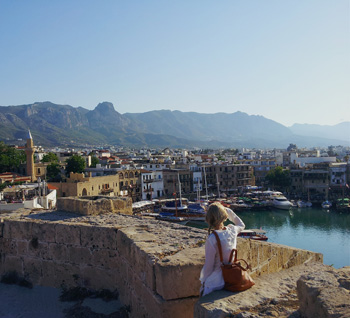 I believe the title of that conference couldn’t have been more appropriate and topical. The island of Cyprus is divided into two parts, despite the international community does not approve this division. The north has been occupied by the Turkish army in the Seventies, and since then there is a government that totally depends on Ankara.
I believe the title of that conference couldn’t have been more appropriate and topical. The island of Cyprus is divided into two parts, despite the international community does not approve this division. The north has been occupied by the Turkish army in the Seventies, and since then there is a government that totally depends on Ankara.
On my way to the campus I chat with the taxi driver, a pure Turkish-Cypriot who, after having spent many years in Europe, has decided to go back to his homeland for the love of his country. I heard it was better not to talk about the complicated political situation, unless you are invited to by a local. The guy, though, didn’t wait too long before he addressed politics. Cyprus is his country, and he feels as Cypriot as anybody else who lives in the south of the island. I dare to say that the Turkish North and the Greek South have a huge number of things in common, way more numerous than differences, and the day all Cypriots will focus only on the common things the island will be again one and united.
It’s undeniable that 70 per-cent of the population has a Greek background and the rest has a strong link with Turkey, but all of them used to be part of a mingled and vivid society, before the Greek Regime of the Colonels claimed the entire island and decided it was time have it back supporting a coup d’état that should have replaced the then president with another leader who was much more in favor of a reunification with Greece. Understandably Turkey sent over their soldiers to protect the population of Turkish origin, but before the conflict escalated the British government put the nose again (yes, they had ruled the island until 1960) and drew a line, the so-called Green Line: a buffer zone controlled by an international force to keep the Turkish and the Greeks separated. Whenever a cultural problem occurs, it seems to me that Westerners tend to solve it by making barriers and walls rather than attempting the road of dialogue and mediation.
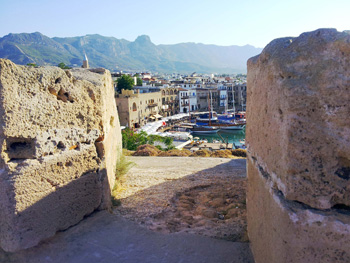 Later on, the south of the island gained its independence but Turkey never gave up the northern territories despite the international community condemned the occupation. That’s why no international flights are scheduled to Northern Cyprus (complete name: Turkish Republic of Northern Cyprus) and Ercan Airport is not listed in any official document that regulates the international air traffic. All the flights to Ercan originate from Turkey and, according to the international law, they technically invade the air space of a sovereign country (the Republic of Cyprus, member of the European Union) and land there illegally.
Later on, the south of the island gained its independence but Turkey never gave up the northern territories despite the international community condemned the occupation. That’s why no international flights are scheduled to Northern Cyprus (complete name: Turkish Republic of Northern Cyprus) and Ercan Airport is not listed in any official document that regulates the international air traffic. All the flights to Ercan originate from Turkey and, according to the international law, they technically invade the air space of a sovereign country (the Republic of Cyprus, member of the European Union) and land there illegally.
Even the postal service represents an exception: all the letters sent to North Cyprus must be addressed to Turkey, because this unrecognized country has never been given a postal code either.
The campus that hosted the conference belongs to a prestigious Turkish educational institution, the Middle East Technical University. It’s modern, neat, comfortable, international and… desert. Yeah, only a few students are still there in July, because the majority of them are already through with the exams and have flown back into their countries of origin.
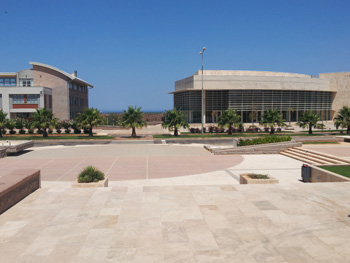 Early in the morning I walk from the guesthouse to the conference center. At eight o’clock it is already warm and the valley which extends beneath the campus towards the south seemed a strip of desert painted in watercolors that gently merged with the Troodos mountains. To the west, the deep blue of the Mediterranean Sea pops up from a remarkable distance. The sunbeams reflected by its surface must have looked exactly the same way 10.000 years earlier when human settlements were already spread throughout the island, making it one of the oldest signs of civilization.
Early in the morning I walk from the guesthouse to the conference center. At eight o’clock it is already warm and the valley which extends beneath the campus towards the south seemed a strip of desert painted in watercolors that gently merged with the Troodos mountains. To the west, the deep blue of the Mediterranean Sea pops up from a remarkable distance. The sunbeams reflected by its surface must have looked exactly the same way 10.000 years earlier when human settlements were already spread throughout the island, making it one of the oldest signs of civilization.
An ancient atmosphere has indeed surrounded Cyprus for millennia. From the foam of its waters, according to the Greek mythology, was born Aphrodite, and the very same shores narrated by that myth had been touched by plenty of ships from different peoples and cultures, sometimes peacefully sometimes threateningly, always sailing from Europe to Asia and the other way around: Mycenaean, Assyrians, Phoenicians, Egyptians, Persians, Romans, Byzantines, Arabs, Venetians, Ottomans… The list can be longer and so could be the plot of the stories that wrapped this island with fascination and magic, from crusaders like the Knights Templars and Knights Hospitallers to slaves and prisoners, from superb castles and inaccessible monasteries to sovereigns like Alexander the Great and Richard the Lionheart.
Kyrenia
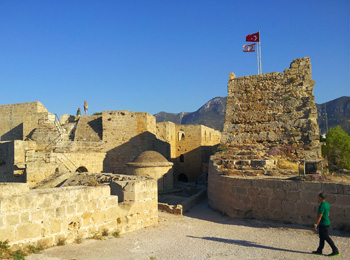 Kyrenia is probably the Cypriot town that better shows this extraordinary heritage at once. On the initial slope of the mountains located right on its back, an imposing Gothic structure known as Bellapais Abbey offers a 3 miles view over an unexpectedly luxuriant vegetation, white villas and turquoise sea. Bellapais is also famous because it’s linked to the British novelist Lawrence Durrell, who lived in that village for some years while he wrote an autobiographical work titled Bitter Lemons of Cyprus.
Kyrenia is probably the Cypriot town that better shows this extraordinary heritage at once. On the initial slope of the mountains located right on its back, an imposing Gothic structure known as Bellapais Abbey offers a 3 miles view over an unexpectedly luxuriant vegetation, white villas and turquoise sea. Bellapais is also famous because it’s linked to the British novelist Lawrence Durrell, who lived in that village for some years while he wrote an autobiographical work titled Bitter Lemons of Cyprus.
The pearl of Kyrenia, though, remains the castle. This great defensive construction has a Fifteenth Century looking although its inner architecture is the precious result of stratifications and diverse styles conceived in previous historical contexts. The ground level is a maze of tangled corridors that sometimes give access to dark underground areas, like the dungeons where several enemies of the kings of Cyprus (Lusignan dynasty) had been imprisoned and tortured, or to a Byzantine church that once used to be outside the defensive structure but that was subsequently incorporated within the new and wider perimeter walls built under the Venetian period.
 The inner courtyard of Kyrenia castle is vast and adorned by blossoming plants and palm trees, which grow at the margin of a dusty field. Somewhere, in a privileged position, it is possible to spot two imposing loggias with lancet arch from which the king and the queen used to watch the games organized on this big open space. The first level of the castle hosts the living quarters, a shipwreck museum and some amazing rooms that offer an authentic medieval atmosphere. Finally, from the circular bastion on the upper level it is possible to admire the picturesque harbor, usually full of ships docked next to the terraces of many bars and restaurants. It’s a lively image of people and colors, hectic tourists walking back and forth or lazy patrons sprawled on wicker chairs sipping cocktails in the mid-afternoon.
The inner courtyard of Kyrenia castle is vast and adorned by blossoming plants and palm trees, which grow at the margin of a dusty field. Somewhere, in a privileged position, it is possible to spot two imposing loggias with lancet arch from which the king and the queen used to watch the games organized on this big open space. The first level of the castle hosts the living quarters, a shipwreck museum and some amazing rooms that offer an authentic medieval atmosphere. Finally, from the circular bastion on the upper level it is possible to admire the picturesque harbor, usually full of ships docked next to the terraces of many bars and restaurants. It’s a lively image of people and colors, hectic tourists walking back and forth or lazy patrons sprawled on wicker chairs sipping cocktails in the mid-afternoon.
The incomparable richness of Cyprus’ history and the fascination of this timeless island are reflected in the environment. Besides the warm temperatures and the pleasantly sunny days, which are typical of any country with a Mediterranean climate. The difference here is that it’s impossible to scuba dive in its transparent waters without thinking of the ancient amphorae and ship from the 4th century BC that sank just a few miles off the shore. As well, as a walk through the olive groves in the neighborhood of Kapouti is unavoidably evocative of the primeval time, when olive trees began to be cultivated. Some of them are still standing after a thousand years for everyone to see, touch the knotty bark or smell the juicy olives.
 Once the conference was over, it was time for me to fly back home. The taxi drove along the motorway through the countryside. The dominant color was due to the yellowish vegetation; the light outside was blinding even despite the tinted glasses of the car. I passed the security check and boarded. The plane took off and climbed out of Ercan’s runway. I tried to spot from that height the campus, the castle and olive groves but something else caught my attention instead: a pair of giant flags drawn on the mountains. The drawings depicted the Turkish flag on the left and, next to it, a rectangle with reversed colors that has been adopted by the Northern Cyprus as their national symbol. A motto accompanied the flags: Ne mutlu Türküm diyene (“How happy is the one who says I am Turkish”).
Once the conference was over, it was time for me to fly back home. The taxi drove along the motorway through the countryside. The dominant color was due to the yellowish vegetation; the light outside was blinding even despite the tinted glasses of the car. I passed the security check and boarded. The plane took off and climbed out of Ercan’s runway. I tried to spot from that height the campus, the castle and olive groves but something else caught my attention instead: a pair of giant flags drawn on the mountains. The drawings depicted the Turkish flag on the left and, next to it, a rectangle with reversed colors that has been adopted by the Northern Cyprus as their national symbol. A motto accompanied the flags: Ne mutlu Türküm diyene (“How happy is the one who says I am Turkish”).
With my eyes still full of beauty and the images of many treasures still vivid in my memory, a veil of melancholy crossed my mind. I hoped for these nice people that their land would become blessed by harmony again soon.

NORTHERN CYPRUS IN A NUTSHELL from Kyrenia
If You Go:
Middle East Technical University, North Cyprus
Ercan Airport, North Cyprus
About the author:
Giuseppe Raudino is a lecturer in Media Theory and Media Skills at the Hanze University of Applied Sciences “Hanzehogeschool Groningen” (the Netherlands). He also works as a freelance writer. You can find him on www.facebook.com/raudinomediatheory or on Twitter @GiuseppeRaudino
All photos by Guiseppe Raudino:
Panorama from Bellapais Abbey
Harbor from Kyrenia Castle
Harbor from Kyrenia Castle
The Campus Conference Center
Kyrenia Castle
Panorama of Kyrenia Castle courtyard
Northern Cyprus Flag drawn on mountains

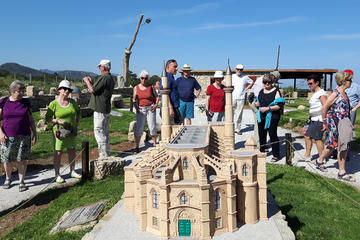
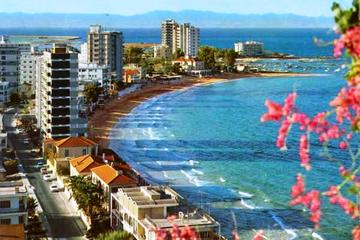


Leave a Reply
You must be logged in to post a comment.